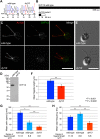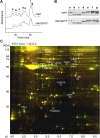TTC26/DYF13 is an intraflagellar transport protein required for transport of motility-related proteins into flagella
- PMID: 24596149
- PMCID: PMC3936282
- DOI: 10.7554/eLife.01566
TTC26/DYF13 is an intraflagellar transport protein required for transport of motility-related proteins into flagella
Erratum in
-
Correction: TTC26/DYF13 is an intraflagellar transport protein required for transport of motility-related proteins into flagella.Elife. 2014 Apr 1;3:e02897. doi: 10.7554/eLife.02897. Elife. 2014. PMID: 24692455 Free PMC article. No abstract available.
Abstract
Cilia/flagella are assembled and maintained by the process of intraflagellar transport (IFT), a highly conserved mechanism involving more than 20 IFT proteins. However, the functions of individual IFT proteins are mostly unclear. To help address this issue, we focused on a putative IFT protein TTC26/DYF13. Using live imaging and biochemical approaches we show that TTC26/DYF13 is an IFT complex B protein in mammalian cells and Chlamydomonas reinhardtii. Knockdown of TTC26/DYF13 in zebrafish embryos or mutation of TTC26/DYF13 in C. reinhardtii, produced short cilia with abnormal motility. Surprisingly, IFT particle assembly and speed were normal in dyf13 mutant flagella, unlike in other IFT complex B mutants. Proteomic and biochemical analyses indicated a particular set of proteins involved in motility was specifically depleted in the dyf13 mutant. These results support the concept that different IFT proteins are responsible for different cargo subsets, providing a possible explanation for the complexity of the IFT machinery. DOI: http://dx.doi.org/10.7554/eLife.01566.001.
Keywords: Chlamydomonas; axoneme; dynein; flagella.
Conflict of interest statement
The authors declare that no competing interests exist.
Figures










Comment in
-
Boarder control on the IFT train.Elife. 2014 Mar 18;3:e02531. doi: 10.7554/eLife.02531. Elife. 2014. PMID: 24642415 Free PMC article.
Similar articles
-
Boarder control on the IFT train.Elife. 2014 Mar 18;3:e02531. doi: 10.7554/eLife.02531. Elife. 2014. PMID: 24642415 Free PMC article.
-
A global analysis of IFT-A function reveals specialization for transport of membrane-associated proteins into cilia.J Cell Sci. 2019 Feb 11;132(3):jcs220749. doi: 10.1242/jcs.220749. J Cell Sci. 2019. PMID: 30659111 Free PMC article.
-
The Chlamydomonas reinhardtii BBSome is an IFT cargo required for export of specific signaling proteins from flagella.J Cell Biol. 2009 Dec 28;187(7):1117-32. doi: 10.1083/jcb.200909183. J Cell Biol. 2009. PMID: 20038682 Free PMC article.
-
The intraflagellar transport machinery of Chlamydomonas reinhardtii.Traffic. 2003 Jul;4(7):435-42. doi: 10.1034/j.1600-0854.2003.t01-1-00103.x. Traffic. 2003. PMID: 12795688 Review.
-
Intraflagellar transport: from molecular characterisation to mechanism.Front Biosci. 2008 Jan 1;13:2633-52. doi: 10.2741/2871. Front Biosci. 2008. PMID: 17981739 Review.
Cited by
-
Genetic and genomic approaches to identify genes involved in flagellar assembly in Chlamydomonas reinhardtii.Methods Cell Biol. 2015;127:349-86. doi: 10.1016/bs.mcb.2014.12.001. Epub 2015 Feb 14. Methods Cell Biol. 2015. PMID: 25837400 Free PMC article.
-
The relationship between intraflagellar transport and upstream protein trafficking pathways and macrocyclic lactone resistance in Caenorhabditis elegans.G3 (Bethesda). 2024 Mar 6;14(3):jkae009. doi: 10.1093/g3journal/jkae009. G3 (Bethesda). 2024. PMID: 38227795 Free PMC article.
-
Review: Intraflagellar transport proteins in the retina.Mol Vis. 2020 Oct 4;26:652-660. eCollection 2020. Mol Vis. 2020. PMID: 33088169 Free PMC article. Review.
-
Cargo adapters expand the transport range of intraflagellar transport.J Cell Sci. 2022 Dec 15;135(24):jcs260408. doi: 10.1242/jcs.260408. Epub 2022 Dec 19. J Cell Sci. 2022. PMID: 36533425 Free PMC article. Review.
-
RABL2 interacts with the intraflagellar transport-B complex and CEP19 and participates in ciliary assembly.Mol Biol Cell. 2017 Jun 15;28(12):1652-1666. doi: 10.1091/mbc.E17-01-0017. Epub 2017 Apr 20. Mol Biol Cell. 2017. PMID: 28428259 Free PMC article.
References
Publication types
MeSH terms
Substances
Grants and funding
LinkOut - more resources
Full Text Sources
Other Literature Sources
Molecular Biology Databases

